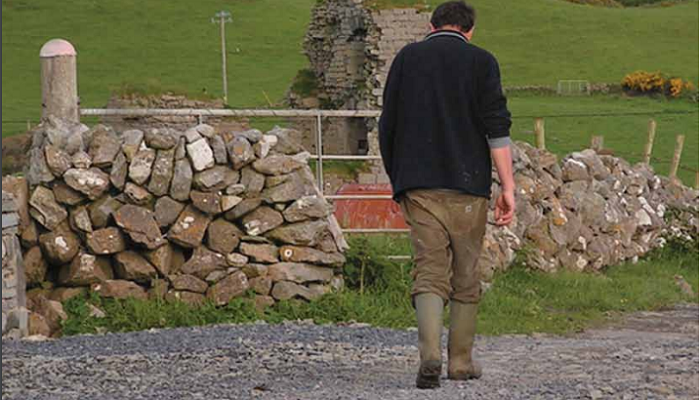14 January 2024
Burnout in the barnyard

John McNamara, Teagasc Health and Safety Specialist, Siobhán O’Connor, DCU, and Emma Dillon, Teagasc REDP tell us how farmers are at risk from stress and mental exhaustion,
A research team at Dublin City University (DCU) working with Teagasc and funded by DAFM, has been studying farmers’ mental health. The team recently published a number of papers including ‘A Review of Burnout issues among Farmers worldwide’ and ‘Alcohol & Substance use among the farming community in Ireland’. Teagasc regards farmer health as a key aspect of sustainability and advocates the ‘Total Health Model’ which recognises that farmer health, mental and physical, is essential in caring for livestock, growing crops and producing healthy and nutritious food.
Two clichés: ‘Your health is your wealth’ and ‘You don’t know what you’ve got till it’s gone’ are more relevant than ever on Irish farms. Burnout, as defined by World Health Organization, is a condition, which includes exhaustion, a sense of alienation and feelings of negativity related to one’s work. Unsurprisingly this leads to chronic workplace stress and reduced work efficiency. Add to that, burnout has been linked with coronary heart disease, Type II diabetes, high blood pressure and psychological distress. Burnout research has mainly focused on social workers, schoolteachers, first responders and recently, healthcare workers during the COVID-19 pandemic.
Farmers have been largely overlooked and an expansion of current burnout research from the field of human services to agriculture is needed. The DCU work began by searching world literature on ‘burnout in agriculture’.
Study findings
Just nine eligible studies were located in the worldwide literature. Compared to non-farmers, farmers experienced higher overall burnout, and higher exhaustion. Gender differences indicated that women experience higher burnout than men. Factors associated with burnout include farming as your primary occupation, in particular being a dairy farmer.
Alcohol and drug use in farming
The DCU team also did research on alcohol and drug use by farmers. The survey size was 271 persons. The study found that 28% of farmers did not drink alcohol, 32% drank within recommended guidelines and 40% drink in excess of advised levels. The vast majority, 95%, of farmers did not use illicit substances. The young were the most likely to consume these. Disordered (problematic) drinking was highest in farmers engaged in full-time education…students in other words. Clearly, misuse of alcohol or substances is harmful to physical and mental health, can lead to stress on families, poor productivity and farm accidents and injury.
Key messages for farmers
Teagasc promotes positive mental health as part of social sustainability and a leaflet on ‘Positive Mental Health’ is available on the Teagasc website. Farming needs to be challenging, profitable and enjoyable to give a positive ‘buzz’. Strenuous work can be curtailed by using modern facilities. Hazards need to be eliminated. The working day must be limited and you must make room for family time and time away from the farm.
Prevention and supports
Farming by its nature does not always run smoothly. Livestock and crops can contract disease, weather has become increasingly variable. Use preventative measures like vaccination and robust buildings to reduce risk.
Having a support ‘team’ is vital: family, friends, advisor, vet, fellow farmers, or a discussion group – all can assist you to overcome challenges as they arise.
Health: Many farmers neglect their health. Getting a regular health check-up should be routine. It will prevent or ‘catch early’ many health conditions. Having this habit means that persons are more likely to seek help when needed. Research indicates that most farmers attend a doctor to treat a condition, but place less emphasis on health prevention measures. We all know that a balanced diet, weight control and exercise are the foundations of good health.
Leisure: Take some time every day for leisure. Breaks and holidays help with health generally and mental health in particular. Exercising in nature such as a forest delivers proven health benefits. Exercise needs to be at a ‘moderate to vigorous’ level to give cardiovascular benefits and can be whatever activity you enjoy.
A further Teagasc booklet ‘Coping with the Pressures of Farming‘ co- written with Mental Health Ireland provides broadly based advice on maintaining positive health.
In summary, we have control of about 60-70% of the risk factors affecting our health in the longer term. Improving ‘Health Literacy’ i.e. having the knowledge to maintain our health has become an important discipline for health promotion. But let’s finish with yet another cliché: ‘It’s no use shutting the barndoor after the horse has bolted’ so please try to prevent burnout rather than having to deal with its consequences.
Teagasc Social Sustainability Indicators
Teagasc recently published Sustainability Indicators for year 2022 based on National Farm Survey data. Key health related findings in the Indicators include:
- About 65-72 % of farmers surveyed, depending on farm enterprise, had visited a doctor in the previous twelve While this is a positive finding, raising this percentage towards 100% is vital. You should use the doctor’s visit to gain tips on disease prevention as well any treatment needed.
- Just 49-52% of farmers took a break from farming in the previous year. This data is of Getting a break from farming is positive for health. Take a holiday!
- About 75-85% of farmers reported having daily social contact. That means nearly one in four farmers don’t. On-going social contact is vital for mental health and
- Time worked on dairy farms was estimated at 2,695 hours per annum, which was far higher than other enterprises: Tillage1,615 hours; Sheep1,584 hours, Cattle Other 1,425 hours and Cattle Rearing 1,460 hours per annum. Working excessively long hours is associated with burnout, stress and a deterioration in health.
- Managing scale and worktime by using both technology and improved farm practices is vital to cutting work time, which is associated with better health and safety in the long term.
This article first appeared in Today’s Farm – November/December 2023, read more here
